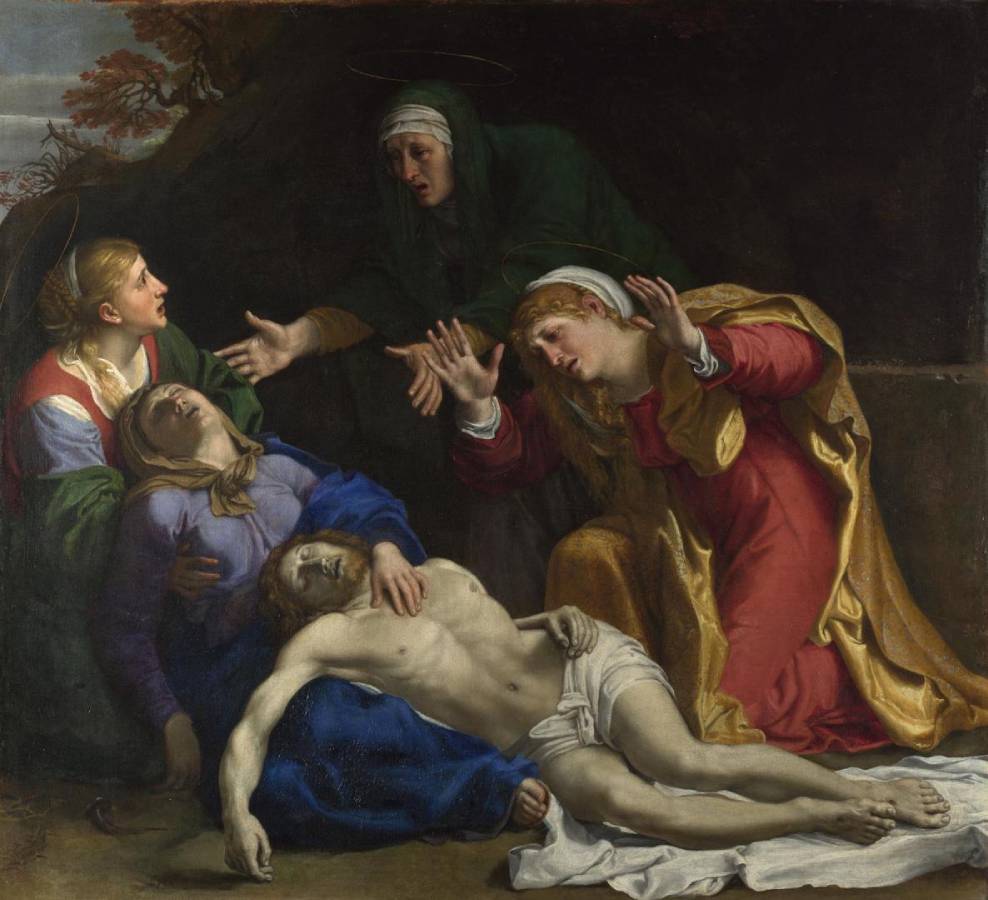Carracci, Annibale (1560-1609)
Pietà con le tre Marie (The Dead Christ Mourned, The Three Maries)
c.1604
Oil on canvas, 92.8 x 103.2 cm
National Gallery, London
This is perhaps the most poignant image in the National Gallery’s collection of the pietà – the lamentation over the dead Christ following his crucifixion – and one of the greatest expressions of grief in Baroque art. Christ’s limp and lifeless body lies in the lap of his mother, the Virgin Mary. A distraught Mary Magdalene, in her traditional red and with long fair hair, kneels on the right, hands raised and mouth open in a wail of anguish. At the back an older woman in dark green reaches out towards the fainting Virgin, whose weight is supported by a fair-haired young woman. Behind them looms a dark entrance to the stone tomb in which Christ will be buried.
The four Gospels all differ in their accounts of what happened after the Crucifixion, but the mourning for Christ by the women closest to him is not recounted in any of them. Conventional depictions of events following the Crucifixion tended to focus on the lamentation over the dead Christ, the Entombment, or the moment that the Three Marys discovered Christ’s empty tomb after the Resurrection. Annibale has compressed these episodes for maximum emotional impact. The identity of some of the women in the picture remains uncertain, but the trio at the tomb were said to have been the Virgin Mary, Mary Cleophas and Mary Salome, all of whom had also been present at the Crucifixion. The older woman in the background is perhaps Mary Cleophas, and the younger one on the left may be Mary Salome.
This is the last in a number of variations on the theme of the pietà, to which Annibale Carracci returned frequently, especially during the last decade of his life. The composition is heavily dependent on the work of Correggio, whose Lamentation (Galleria Nazionale, Parma) Annibale would have had the opportunity to study during his visit to Parma in the 1580s. The composition is built on strong diagonals and our eye is guided around the picture by colour, gaze and expression. Christ’s limp and lifeless body is laid out in the foreground, the arrangement of his limbs echoed by those of his unconscious mother, linking them both structurally and emotionally. Her left hand – the only one in the picture to touch him – lies on his shoulder, and even his grey face, suggesting the onset of rigor mortis, is reflected by her deathly pallor. Our eye is led up Christ’s elongated torso to his mother’s face, and then the tones changes from cool blues to warmer flesh colours, the red bodice and golden hair of the girl supporting the Virgin. Her gaze, pointed towards the older woman, redirects ours. From this figure in half shadow our eye is drawn forwards and downwards to the bright clothing of Mary Magdalene, whose concentrated anguish is directed at Christ, bringing our attention back to him.
Annibale has skilfully concentrated our attention on each figure and her emotional response in turn. His ability to paint different emotions is exactly what appealed to later admirers of this painting. Its brilliant combination of formal classicism with intense human sentiment, places Annibale’s art on a par with that of the great Renaissance painters Correggio and Raphael, and prefiguring the works of Nicolas Poussin. (NG)
